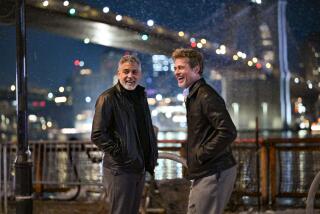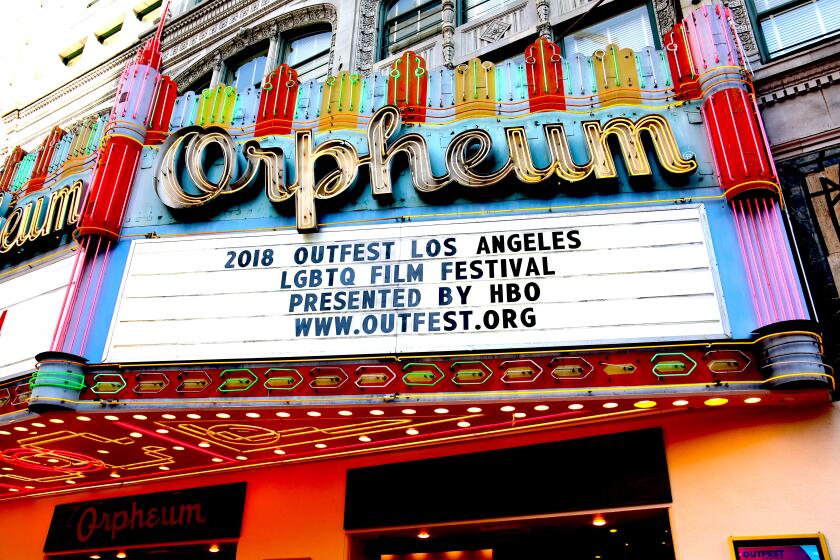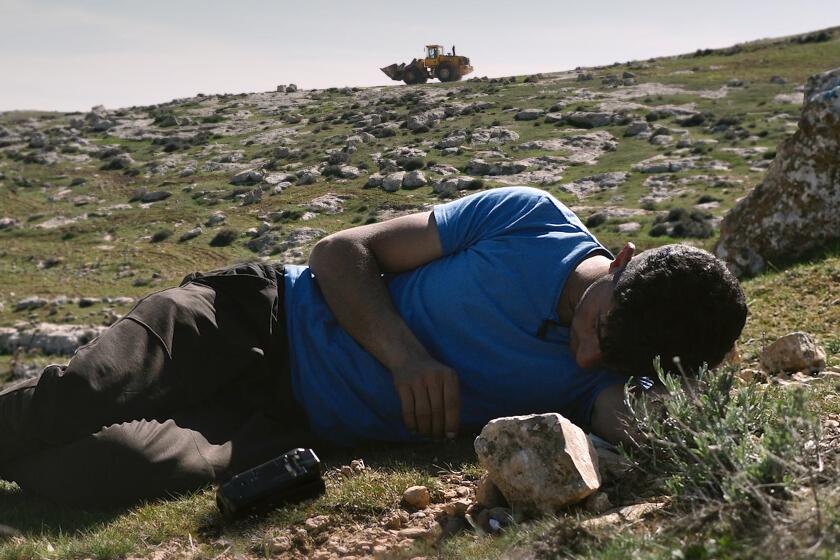Quentin Tarantino shocks Cannes again with epic ‘Once Upon a Time ... in Hollywood’
Reporting from Cannes, France — Times critic Justin Chang is filing regular dispatches from the 72nd annual Cannes Film Festival, which runs May 14-25 in France.
The day before the Cannes premiere of “Once Upon a Time … in Hollywood,” his hotly anticipated movie set in Los Angeles during the tumultuous events of 1969, Quentin Tarantino published an open letter online. He addressed it to audiences at the festival, opening with the words “I love Cinema,” which may be the most redundant thing this movie-mad auteur has ever written (and given his endless, self-admiring flurries of dialogue, that is saying something). The letter then implored us not to reveal “anything that would prevent later audiences from experiencing the film in the same way.”
A version of this entreaty was repeated from the stage by a festival representative shortly before the picture screened Tuesday for members of the press, some of whom booed and snorted in response. I didn’t join in. Even as someone who believes that excessive spoiler sensitivity is a sign of an entitled, infantile approach to moviegoing, it’s easy to understand Tarantino’s anxiety, especially after a leaked script nearly led him to shelve “The Hateful Eight.” (Many, of course, still wish that he had.)
READ MORE: ‘Once Upon a Time in ... Hollywood’ trailer offers more clues to Tarantino’s latest »
Twenty-five years after “Pulp Fiction” won the Palme d’Or at this festival, Tarantino’s movies may no longer have quite the same audacity or revelatory power, but the ability to shock — and, if you’re lucky, to make you think — remains an important tool in his kit. This turns out to be the case even when he’s dealing with real-life subjects such as Sharon Tate, Roman Polanski and members of the Charles Manson cult, whose well-documented stories would, by now, seem beyond spoiling.
Not quite, apparently. I will do my best to oblige Monsieur Tarantino and his collaborators on this richly evocative, conceptually jaw-dropping, excessively foot-fetishizing, inescapably terrifying and unexpectedly poignant movie. Still, if you wish to preserve the purity of a first viewing, it is probably best if you read no further, and that you read nothing else about the movie before Sony Pictures releases it in U.S. theaters July 26.
Like Tarantino’s 2009 picture, “Inglourious Basterds,” “Once Upon a Time … in Hollywood” is both a luxuriant, sometimes lumbering ode to a bygone era of moviemaking and a singularly bold reinterpretation of a violent chapter of history. The title is practically a spoiler in itself: We are not just in the dream factory, but also within the realm of fantasy. Our guides to this cracked-mirror vision of Hollywood, which kicks off in February 1969, are Rick Dalton (Leonardo DiCaprio), an actor whose career peaked years ago with the western TV series “Bounty Law,” and Cliff Booth (Brad Pitt), a war veteran who is Rick’s longtime stunt double and best friend.
The first screen pairing between DiCaprio and Pitt proves worth the wait, even if the practical realities of the actor-stuntman relationship don’t seem to interest Tarantino all that much. That’s fine; the personalities are what matter. DiCaprio, his golden-boy wattage persuasively dimmed, is both mockable and sympathetic as a handsome has-been actor, the unwitting star of his own male midlife-crisis movie. He’s cradled beautifully by Pitt as the most loyal of pals, someone who’s always there to lend a shoulder — or some serious muscle — as needed. (The second-billed Pitt may be playing the lower man on the industry totem pole, but this is very much his movie.)
It would be a hoot to watch these stars in boozy, cigarette-chomping buddy-comedy mode even if they weren’t tethered to such a loving and persuasive re-creation of the movie industry at the time. Fans of the era may be reminded of legendary actor-stuntman pairings such as Burt Reynolds and Hal Needham, and some will supply their own real-life reference points for Rick and Cliff’s work, even if they are unable to match Tarantino’s characteristically obsessive scholarship.
For most of its 159-minute running time, ‘Once Upon a Time …’ both does and doesn’t behave the way you might expect a Quentin Tarantino picture to behave.
“Bounty Law” is a distant cousin of western serials including “Gunsmoke” and “Bonanza.” One of Rick’s more successful movies, “14 Fists of McCluskey,” might be a callback to “The Dirty Dozen.” Barbara Ling’s production design is a wittily intricate treasure trove of fake movie memorabilia, though there’s some real stuff in the mix too. A one-sheet for the 1949 Roy Rogers western “The Golden Stallion” is just one of many decorating the walls of Rick’s Benedict Canyon home.
Yes, Benedict Canyon. The early sight of a Cielo Drive street sign cuts ominously through Tarantino’s flood of references and reminds you that he does have a very dark story to tell. That story is slow to coalesce, however, in a movie that doesn’t always draw a distinction between period detail and narrative thrust. Is Mike Moh’s amusingly cocky Bruce Lee impersonation a gratuitous touch or a key piece of foreshadowing? Do the extensive scenes of Rick struggling on the set of his latest movie count as character development or mise-en-scène overkill? (Thanks to Julia Butters’ lovely performance as Rick’s preternaturally confident child costar, I didn’t much care either way.)
For most of its 159-minute running time, “Once Upon a Time … in Hollywood” both does and doesn’t behave the way you might expect a Quentin Tarantino picture to behave. The storytelling is entirely linear. The talk loops and drones endlessly, as usual, but it’s also slow to gather momentum. The loose hangout vibe achieves some of the mellowness and melancholy of “Jackie Brown” (a very good thing). A chill enters the picture whenever attention shifts to the Manson family, especially when we arrive at their temporary digs at the Spahn Movie Ranch, but overt acts of violence are (initially) few and far between.
Given the movie’s lurching stop-and-go rhythms, you could blink and miss some of the actors listed in the huge ensemble cast. You will, however, remember the faces of Bruce Dern and the late Luke Perry (in one of his last performances), and also of Margaret Qualley, Austin Butler, Mikey Madison and Dakota Fanning as Mansonites. Most of all, perhaps, you will remember Margot Robbie in the role of Sharon Tate, who pops up every so often, hijacking the narrative as she goes about her day, her luminous presence working in almost contrapuntal rhythm to the main story.
I am both reluctant and obliged to say more. When the picture was first announced in 2017, many expressed their reservations about Tarantino, not a director known for his tact or sensitivity, taking on a story that would deal with a subject as horrific and painful as the Manson murders. And that was months before the #MeToo storm broke, bringing with it the downfall of Tarantino’s longtime collaborator Harvey Weinstein, plus Uma Thurman’s account of having been subjected to reckless treatment on the set of “Kill Bill.” A resurfaced 2003 audio clip of Tarantino defending Roman Polanski (played by Rafal Zawierucha in a few scenes) didn’t help matters.
In short, “Once Upon a Time … in Hollywood” arrived in Cannes on Tuesday saddled with the kind of foul-smelling baggage that perhaps only a filmmaker of Tarantino’s reputation, an artist still revered as one of the industry’s last true big-picture originals, could possibly overcome.
Does he overcome it? It’s far too early to tell. But after a first viewing, it seems clear to me that Tarantino delved into this project intent on allaying our worst fears and doing right by his subject. And he does this, of course, in the language he speaks best: the love of cinema.
Where the character of Sharon Tate is concerned, that love takes the form of a seemingly unconnected subplot that shows her casually walking up to a Westwood theater screening her 1968 movie “The Wrecking Crew.” We see the real Tate light up the big screen, and Robbie’s eyes glow with joy in the audience, as she watches the person she’s playing. It’s a moving act of homage, and it is not, crucially, the only way in which Tarantino seeks to inspire a fresh and compassionate reconsideration of Tate’s memory.
The final act of “Once Upon a Time … in Hollywood” is funny, scary, troubling and exhilarating by turns; the meandering structure clicks into place as it becomes clear where Tarantino has been taking this story and, given his track record, perhaps could only have taken this story.
This is hardly the first time that this director has turned fiction and reality into blood-slicked bedfellows; nor is it the first time he has made the outrageous suggestion that cinema, as both an art and an industry, can make up for some of life’s most grievous imperfections in ways that nothing else can. Spoilers or no spoilers, you may not be terribly surprised, which doesn’t mean you won’t be astonished.
More to Read
Only good movies
Get the Indie Focus newsletter, Mark Olsen's weekly guide to the world of cinema.
You may occasionally receive promotional content from the Los Angeles Times.











